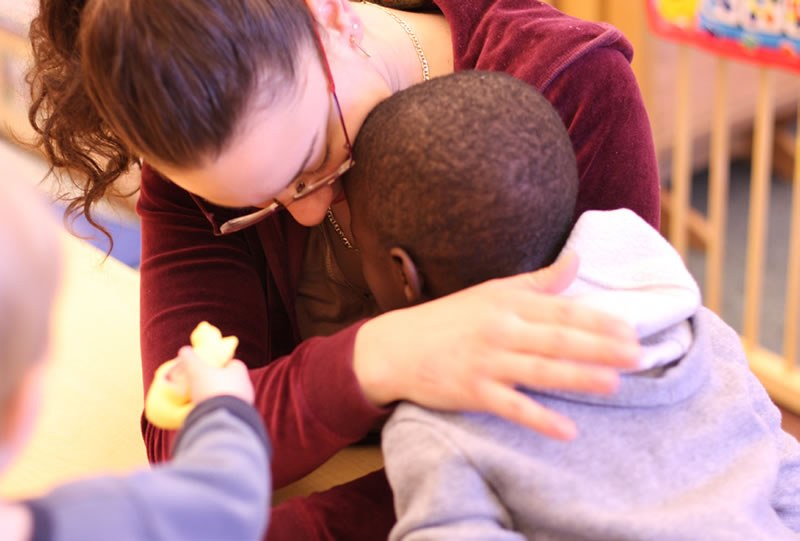Most adults depend on the TV, radio, and newspapers to find out what’s happening in local areas and in the world. Adults may forget that children are seeing and hearing the same news reports. Stories and pictures that may not seem bad to adults can be confusing and frightening to young children.

Understanding how the news works can help when you're talking with children about a news story.
Seeing and hearing the news can be scary for children.
- News reports pick up on things that are different. They don't cover day-to-day life. This is difficult for children to understand. The news doesn't show cars driving on the road every day, but if there's a big car accident, it's in the news.
- The news often reports only the simple facts of a story. News reporters are told to write about, who, what, where, when, and how when covering a story. This doesn't leave much space for more information. The average TV news story is only thirty seconds long. This means that children hear who is killing whom, without knowing why people are fighting.
Children of different ages will see the news in different ways
Preschool age children
Children under six years old have a hard time telling the difference between what they see in the news from what is pretend or things they see in any other TV show. A car wreck in the news looks the same to them as a car wreck in a movie. Many children who saw the news reports from September 11, which showed the planes crashing into the World Trade Center, thought there were many planes crashing into the buildings over and over again. Preschoolers may be as afraid of things they see in the news as they are of a monster under their bed.
You may find that some children know nothing about what's happening in the news. That's ok. If they don't ask questions and they aren't showing any signs of the effects of the news, you don't need to tell them.
Elementary school age children
Children in this age range may have the most problems from what they see or hear in the news. These children know the difference between what's real and what's pretend, but they have trouble seeing things from the right point of view. If they hear about robbers or murder in their area, they often think these things happen every day. They tend to worry about the dangers they see, like car wrecks, getting kidnapped, or floods.
Helping children with the news
- Turn off the TV and radio. Make your house a safe place where children don't need to see or hear the news. They may still have contact with the news at home or other places, but think of your house as a place where children can play and learn without bringing in fears from the outside world.
- Let children know they can talk with you. The best way to help children feel safe is to talk with them about what they see and hear. When a child talks about something frightening, find out what he knows about it. Sometimes what the child is thinking is very different from the truth. It's important to always tell children the truth about what happened, using words that you feel the child can handle.
- Some children will show their feelings in actions instead of words. Watch for children who may have new fears, headaches or stomach aches, trouble eating or sleeping, or other changes in their behavior. Talk with them about what you see. "Karen, you seem to be worried about something. Would you like to talk about it?"
- Talk with children about the difference between the news and real life. Yes, the news is real, but watching the news can make people think there are more problems in the world than what's really happening.
- Talk with children about their fears. Even though what's happening in the news may not take place in your neighborhood, children may still be afraid. It's important to talk with children about their fears and remind them that you, parents, and other adults are there to keep them safe. You may even want to talk about policemen, doctors, firefighters, and other people who work to keep people safe. This would be a good time to go over safety plans with the children so they know what to do in case of a problem.
- Try to keep a normal routine. Children like it when they know what to expect during the day. A routine makes children feel safe and helps them to stay calm.
- Play is one of the best ways for children to work through their concerns. It's ok for children to play funeral or hospital if that's what they are thinking about. Pretend play is a good way for children to make their own sense of what's happening in the world.
Let children know they can talk with you about their fears.
Even war play can be a way for children to work out their feelings. It's very important for an adult to stay near when children are playing war. Be ready to stop the play before anyone gets hurt. An adult can sometimes move war play in a different direction by talking about making a hospital for the wounded or food for the soldiers. Pretending to be helpers makes this play safer and reminds children there are always helping people in the world.
- Find ways for children to help others. Helping others gives children a sense of control and gives them a chance to show their care for other people. Ask children what they would like to do to help out. This could be something like bringing clothes for a family who had a house fire, helping an older person, or collecting pennies to send to buy food for children in other countries.
Tips 4-11

